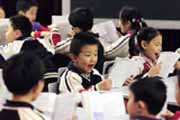 A revolution in early education is happening in some local schools - they're teaching Chinese.
A revolution in early education is happening in some local schools - they're teaching Chinese.
It's not as absurd as it sounds. For many years, a child's first textbook encounter with Chinese was through "pinyin," the phonetic translation of Chinese characters into the Western alphabet.
That is no longer the case. A new primer for first graders begins with Chinese characters - an approach that's winning the approval of youngsters.
Zhu Chengyuan, 7, for example, pores over the new text as soon as he gets home from school.
"He's taken a strong interest in learning Chinese characters almost without knowing it," says his father Zhu Ziqing. "He can already read picture books and the like."
Under the former system, he wouldn't encounter this type of material until two years later. The 7-year-old is one of about the 20,000 first-graders in Shanghai who are part of a pilot program using the new textbook, and by September 2003, all first graders in Shanghai will begin their first semester with the new textbook.
"The book is designed to cultivates kids' interest in learning Chinese by improving their reading skills at an earlier age," says Xu Genrong, the book's editor. "The text exposes children to basic Chinese characters that appear in everyday life. This is a natural and pragmatic approach to early education."
The old emphasis on "pinyin" alienated some students, and was criticized by educators. "We used to spend 45 minutes practicing the pronunciation of just the three phonetic alphabet, a o e," says Sheng Chun, Zhu Chengyuan's teacher. "It required no imagination and students quickly became bored." That system is still practiced in the rest of the country.
"The rote 'pinyin' drills last for five or six weeks under the old system," says Xu, "and kids stop concentrating."
Repetitive writing exercises have been scaled back in the new text in favor of reading skills.
"Pinyin" is not abandoned in the new text, but only appears after roughly six weeks of coursework in lesson 9, but the stress is on reading, not writing.
The editor of the book maintains that students using the new method will learn some 800 Chinese characters by the end of the first semester, as opposed to 300 under the former system.
"Using the old text, pupils learned to read and write a character, as well as learning its 'pinyin' transcription," says Xu. "These elements were taught together, and that put a heavy burden on students."
Early result from the pilot scheme shows that without this focus on writing, kids learn characters far more quickly.
"With the new text, kids learn more Chinese characters sooner, and they have the urge to do more reading, which enhances their understanding of Chinese language and culture."
To further encourage an interest in culture, the new book has increased ancient poems, fairy tales and everyday life mertials. In the previous book, after the 'pinyin' period, the kids were taught simple characters in a very simple context.
Results from earlier tests using the new teaching methods were positive, with the children being able to read while their peers, taught in the traditional way, were still asking their parents to read to them.
A new testing system is also being introduced in tandem with the new book. Replacing the older written test, it gets students involved in a range of activities to test their reading comprehension. The kids are asked to listen to the tapes, then to do the matching work in the paper. Some teachers are concerned that the increase of Chinese characters could pose a burden to the kids. But the two-year trial with the experimental books indicates the contrary, said Xue Feng, an official from Textbook Research Center of the Shanghai Education Committee.
(eastday.com December 13, 2001)
